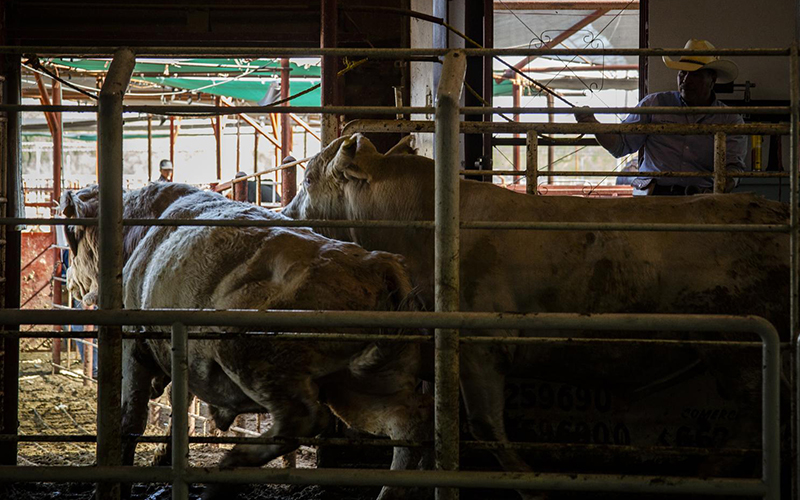
“Because of the drought, we’re often forced to get rid of productive herds,” says Oscar Camou, director of operations with the Sonora Regional Cattle Union in Hermosillo. (Photo by Murphy Woodhouse/KJZZ)

A typical Thursday auction in Hermosillo this time of year will bring 250 to 300 head. In recent weeks, cattlemen say, the number has reached 700. (Photo by Murphy Woodhouse/KJZZ)
HERMOSILLO, Mexico – On a recent Thursday afternoon on the outskirts of town, a livestock auctioneer is taking bids. A long line of cattle – ribs pushing against taut, ragged hides – slowly makes its way through a maze of corrals toward the front.
“They’re thin,” said Francisco Acuña, who has worked at the auctions for five years. “Skinny cows.”
“It’s the worst drought that I’ve seen,” said Oscar Camou, director of operations with the regional cattle union, Unión Ganadera Regional de Sonora.
Recent federal data show that all but one of Sonora’s 72 municipalities have some level of drought. And more than 60% are experiencing extreme or exceptional levels, by far the highest figure in the country. Mexico, like most of the U.S. Southwest, has experienced more than two decades of rising temperatures and aridity.
That means there’s really nowhere for ranchers to take their animals to graze, Camou said. And, with months to go before the desperately needed monsoon rains, which were a bust last year, feeding them is “impossible, economically speaking.”
“Because of the drought, we’re often forced to get rid of productive herds,” he said.
And many ranchers have turned to auction houses to do that. They started with older animals. But as the drought has dragged on, Camou said, they’ve started unloading young, productive animals, undoing years of painstaking work.
A typical Thursday auction this time of year will bring 250 to 300 head, he said. In recent weeks, they’ve seen as many as 700.
“There’s a lot of supply, a lot of supply,” he said when asked whether the high numbers have meant falling prices for ranchers. “And as time passes, the physical condition of the animals is falling, and the skinnier an animal, the lower the price.”
Losing rural roots
“Of course there are going to be repercussions,” said Jesús Ancheta, the union’s marketing director.
Ranching directly supports more than 30,000 families in Sonora, whose state seal prominently features an imposing bull. But Ancheta said it’s also a key economic activity tying people to the state’s rural communities. A hit like this could mean some ranchers pull up stakes and head to the cities.
“Often when they sell that cattle, then they don’t have anything that keeps them there,” he said.
One northern Sonora rancher, Cuauhtémoc Cañez, told KJZZ that after selling off much of his herd, which had been thinned a few dozen deaths, he doesn’t know what comes next.
Ancheta said ranchers also are selling off young cows necessary to repopulate herds when — and if — the rains return. That could spell significantly reduced income and exports for several years to come.

A cowboy keeps the line moving at a recent auction at the Sonora Regional Cattle Union headquarters. Prices are falling as the animals get thinner because of drought. (Photo by Murphy Woodhouse/KJZZ)
Acres left fallow
And ranching isn’t the only agricultural sector getting slammed by drought.
Rodolfo Jordan Villalobos, state head of the National Campesino Federation, which represents small farmers, ranchers and farmworkers, said about 70,000 acres will go unplanted in the Mayo River Valley, one of Sonora’s key agricultural areas.
That alone spells a production decline of tens of thousands of tons of wheat, a critical commodity for the state.
“I don’t even want to think about the rains coming as they did” last year, he said of 2020’s dismal monsoon season.
In December, the federal government declared a natural disaster in 43 Sonoran cities and towns because of the drought. In 2020, rainfall was half what it had been the year before.
But a regional representative of the National Water Commission told reporters the declaration would only serve to guarantee human access to water, and not address the agricultural impacts. Villalobos and others said they have not seen substantial aid from Mexico City.
“We don’t have any support, not from the state, not from the federal government, no one,” said Cañez, the northern Sonora rancher.
But the cattle union’s Ancheta said no amount of money can solve the problem. Only rain can do that.
Wake-up call
Some are hoping that the current drought serves as a wake-up call.
América Lutz, a researcher at the Colegio de Sonora who studies water resources in arid regions, said the drought likely is tied to a La Niña weather pattern, which historically means less precipitation in the region.
But she said “common sense and logic” also point to an important — although difficult to quantify — role played by climate change, which is expected to bring continued hotter, drier conditions to the region by the middle of the century.
But that doesn’t mean the climate “is waiting for 2050 to arrive to start manifesting itself,” Lutz said.
Having better data about the smaller, regional scale impacts of climate change will be an important part of preparing and adapting in coming decades, she said, as will better public environmental education.
But rethinking the state’s dependence on water-intensive industries, such as mining, export agriculture and ranching, also will be critical, Lutz said.
“Not doing (these things) will cost us dearly toward the end of the century,” she said.
The Fronteras Desk is a unique KJZZ project that covers a wide expanse of an undercovered news desert that stretches from northern Arizona deep into northwestern Mexico.
